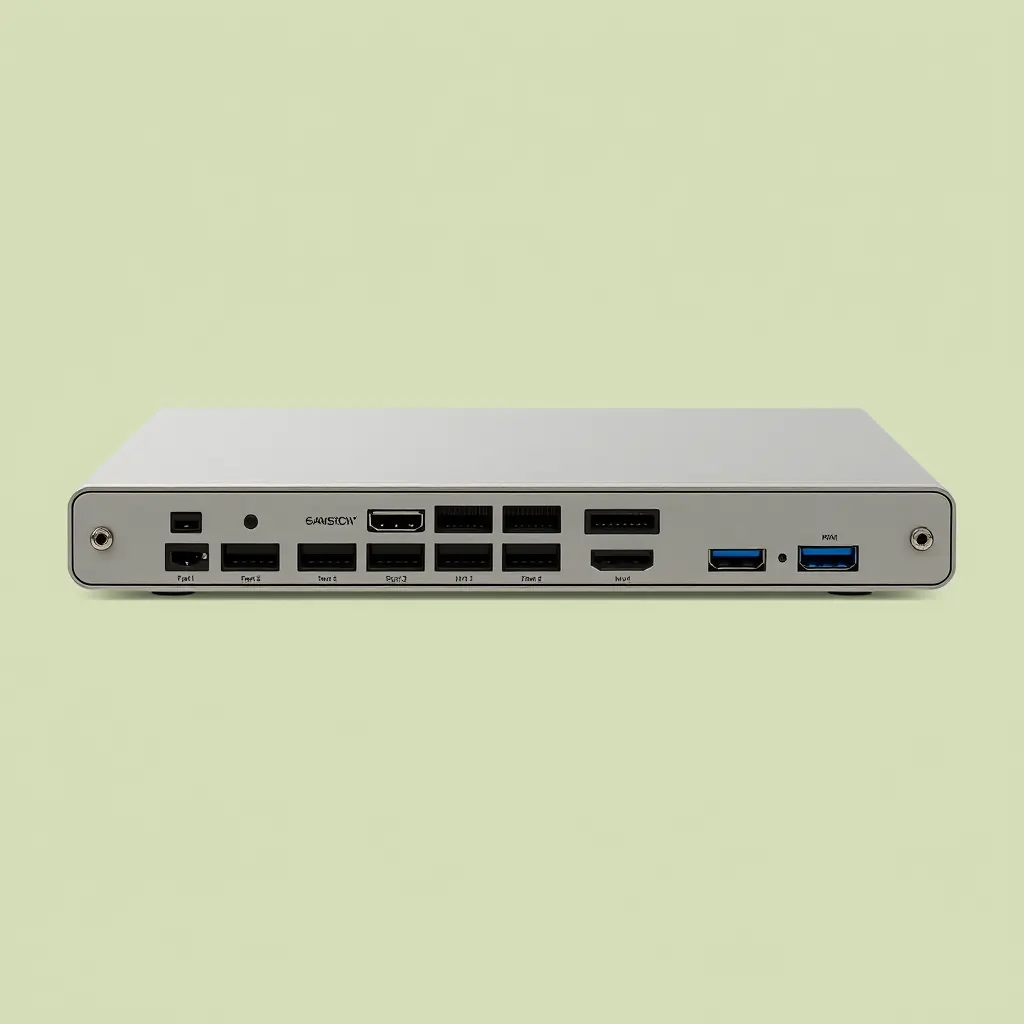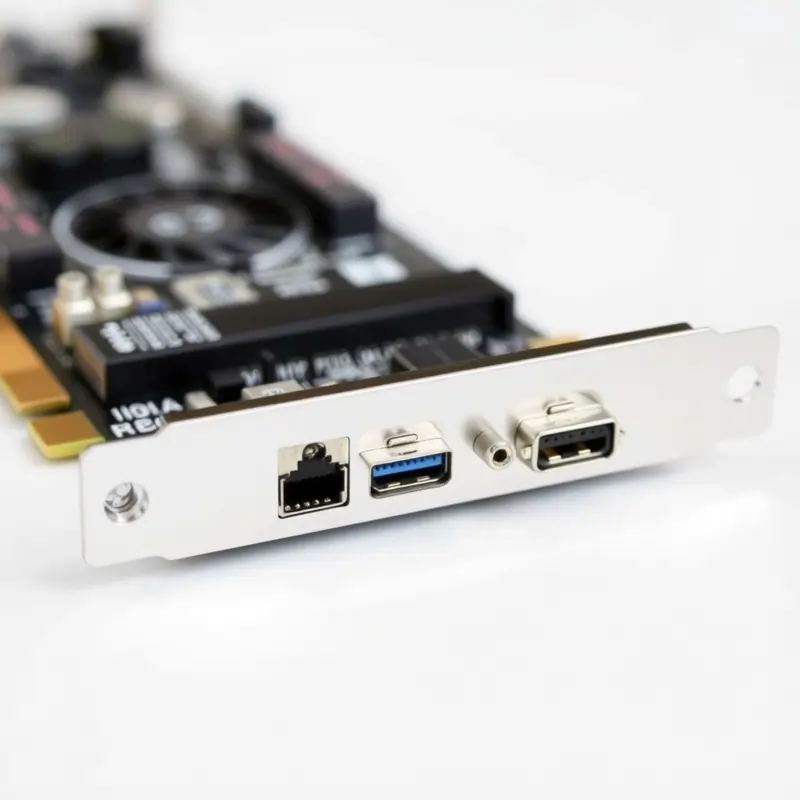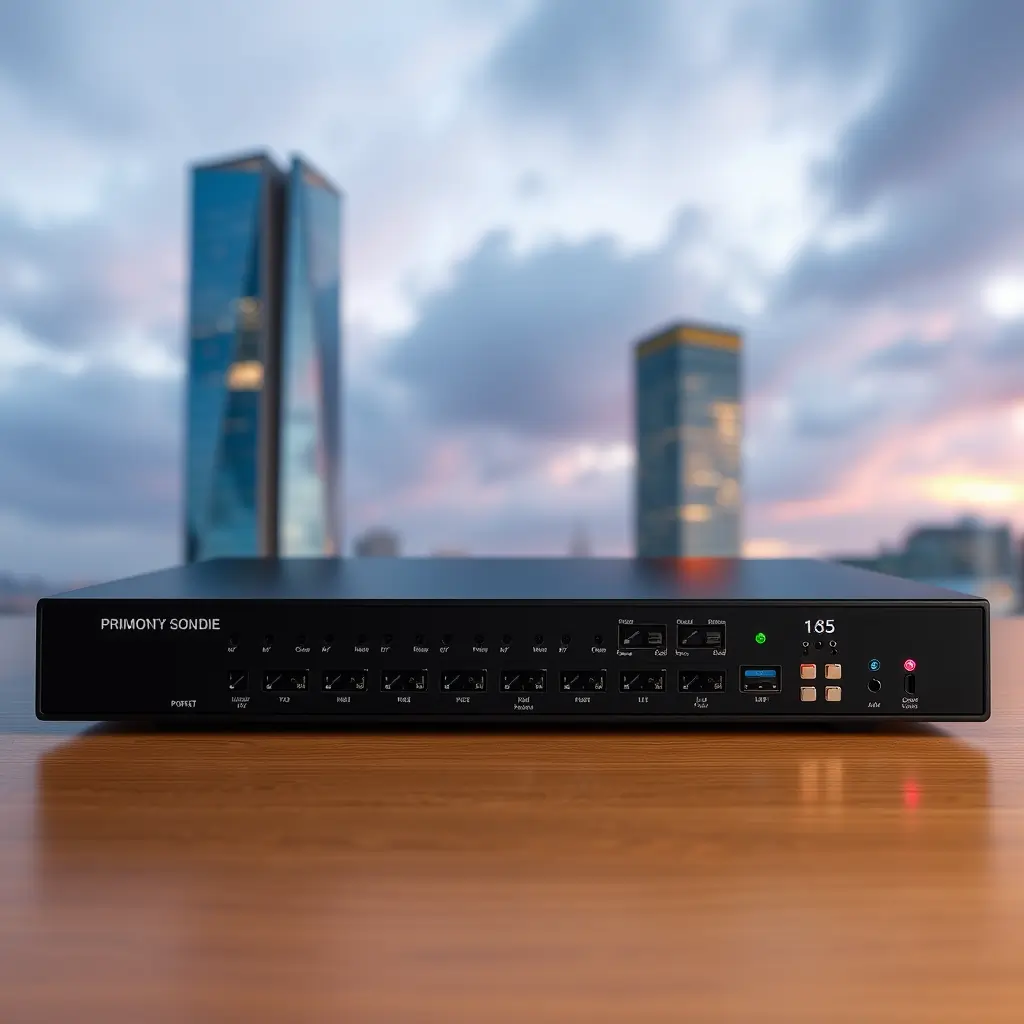When setting up your gaming or professional workstation, the choice of display port on your GPU (Graphics Processing Unit) plays a crucial role in determining the quality of your visuals. This guide will help you understand the different types of GPU display ports, how to choose the right one, and what to do if your display port isn’t working.
What is a GPU Display Port?
A GPU display port (DP) is an interface used to connect your GPU to your monitor. It’s responsible for transmitting video and sometimes audio signals from your computer to the display. The right display port ensures you get the best performance usage out of your monitor, whether you’re gaming, editing videos, or simply browsing the web.
Types of GPU Display Ports

Choosing the correct display port to use on your GPU depends on your needs most common types:
DisplayPort (DP) is a digital display interface used to connect a video source to a display device. Understanding the different types of DisplayPort connections can help you make informed decisions for optimal performance. Here’s a breakdown of the various DisplayPort types:
1. Standard DisplayPort (DP)
- Description: The original version of DisplayPort, introduced in 2006.
- Features:
- Supports up to 8.64 Gbps bandwidth.
- Capable of 4K resolution at 60Hz.
- Supports multiple displays through Multi-Stream Transport (MST).
2. Mini DisplayPort
- Description: A smaller version of the standard DisplayPort, commonly found on laptops and tablets.
- Features:
- Supports the same capabilities as standard DisplayPort.
- Compatible with Thunderbolt connections.
- Ideal for portable devices due to its compact size.
3. DisplayPort 1.2
- Description: An updated version released in 2010.
- Features:
- Increased bandwidth of up to 21.6 Gbps.
- Supports 4K resolution at 60Hz and 1080p at higher refresh rates.
- Enables daisy chaining of multiple monitors using MST.
4. DisplayPort 1.3
- Description: Released in 2014, further enhancing capabilities.
- Features:
- Bandwidth increased to 32.4 Gbps.
- Supports 5K resolution (5120 x 2880) at 60Hz.
- Improved audio support, including up to 32 channels.
5. DisplayPort 1.4
- Description: An extension of DP 1.3, launched in 2016.
- Features:
- Introduces Display Stream Compression (DSC) for lossless compression.
- Supports 8K resolution (7680 x 4320) at 60Hz with DSC.
- Enhanced HDR (High Dynamic Range) support for better color and brightness.
6. DisplayPort 2.0
- Description: The latest iteration, released in 2019.
- Features:
- Massive bandwidth of up to 80 Gbps.
- Supports 8K resolution at 120Hz without compression or 16K at 60Hz with DSC.
- Improved support for HDR and variable refresh rates, making it ideal for high-end gaming and professional applications.
7. HDMI (High-Definition Multimedia Interface)
HDMI is one of the most widely used display ports. It’s versatile and supports both video and audio transmission, making it a popular choice for gamers and multimedia enthusiasts. However, while HDMI can support high resolutions, it may not be the best option for high refresh rates compared to DisplayPort.
8. DisplayPort
DisplayPort is often the go-to option for those needing high resolutions and refresh rates, especially in gaming and professional setups. It supports multiple monitors with a single cable, making it ideal for multi-monitor setups. If you’re wondering which display port to use on your GPU for the best performance, DisplayPort is usually the top choice.
9. DVI (Digital Visual Interface)
DVI is an older type of display port still found on some GPUs and monitors. While it’s capable of transmitting high-quality video, it doesn’t support audio. DVI is often used with older monitors and is gradually being phased out in favor of HDMI and DisplayPort.
10. VGA (Video Graphics Array)
VGA is a legacy analog display port, once common in older PCs and monitors. While VGA can still be found on some older equipment, it’s not recommended for modern setups due to its lower video quality and lack of support for higher resolutions.
DisplayPort vs. HDMI: Which Is Better for Gaming?

DisplayPort and HDMI are both popular choices for connecting your gaming PC to a monitor, but each has its strengths depending on your specific needs. Here’s a quick breakdown:
Why Choose DisplayPort?
- Higher Refresh Rates: DisplayPort supports up to 240Hz at 1080p and 144Hz at 4K, making it ideal for high-performance gaming.
- Better for Multi-Monitor Setups: DisplayPort allows for daisy-chaining multiple monitors, perfect for immersive multi-display gaming.
- Adaptive Sync Support: DisplayPort is compatible with both NVIDIA G-Sync and AMD FreeSync, reducing screen tearing and stuttering.
Why Choose HDMI?
- Widespread Compatibility: HDMI is found on most gaming consoles, TVs, and monitors, making it a versatile option.
- Ease of Use: HDMI is plug-and-play, carrying both audio and video over a single cable, which is convenient for connecting to a TV or sound system.
- Latest HDMI 2.1 Features: HDMI 2.1 supports 4K at 120Hz and 8K at 60Hz, along with Variable Refresh Rate (VRR) for smooth gaming.
The Verdict
- Go with DisplayPort if you’re a PC gamer focused on high refresh rates, multi-monitor setups, or using adaptive sync technologies.
- Choose HDMI if you need broader device compatibility, especially with consoles or if you’re connecting to a TV.
For most gamers, DisplayPort will offer the best experience, especially for high-refresh-rate gaming on a PC monitor. However, HDMI is still a solid choice, particularly for console gaming or connecting to a television.
DisplayPort vs. HDMI: Spec Comparison
When comparing DisplayPort and HDMI, it’s essential to understand their specifications to determine which is better suited for your gaming or professional needs. Here’s a breakdown of the key specs:
| Feature | DisplayPort 1.4 | DisplayPort 2.0 | HDMI 2.0 | HDMI 2.1 |
|---|---|---|---|---|
| Maximum Bandwidth | 32.4 Gbps | 80 Gbps | 18 Gbps | 48 Gbps |
| Maximum Resolution | 8K (7680×4320) @ 60Hz | 10K (10240×4320) @ 60Hz | 4K (3840×2160) @ 60Hz | 10K (10240×4320) @ 120Hz |
| Maximum Refresh Rate | 144Hz @ 4K | 144Hz @ 8K | 60Hz @ 4K | 120Hz @ 4K, 60Hz @ 8K |
| Multi-Stream Transport (MST) | Yes | Yes | No | No |
| Adaptive Sync Support | FreeSync, G-Sync | FreeSync, G-Sync | Limited (AMD FreeSync over HDMI) | VRR (Variable Refresh Rate), FreeSync |
| Audio Support | Yes, up to 8 channels | Yes, up to 32 channels | Yes, up to 32 channels | Yes, up to 32 channels |
| Cable Length | Up to 3 meters for full resolution and refresh | Up to 3 meters for full resolution and refresh | Up to 10 meters for full resolution | Up to 10 meters for full resolution |
| Compatibility | PCs, monitors, some professional displays | PCs, monitors, professional setups | TVs, gaming consoles, PCs, monitors | TVs, gaming consoles, PCs, monitors |
| Audio Return Channel (ARC) | No | No | Yes | Yes (eARC) |
| HDR Support | Yes (HDR10, HDR10+, etc.) | Yes (HDR10, HDR10+, etc.) | Yes (HDR10, Dolby Vision, etc.) | Yes (HDR10+, Dolby Vision, etc.) |
Key Takeaways:
- DisplayPort 1.4: Ideal for gamers needing high refresh rates and resolutions, with robust multi-monitor support via MST.
- DisplayPort 2.0: Future-proof option with massive bandwidth, supporting up to 8K at 144Hz, making it perfect for top-tier gaming and professional use.
- HDMI 2.0: Suitable for general use with broad compatibility, great for 4K at 60Hz setups, and commonly found in TVs and consoles.
- HDMI 2.1: Offers the latest features like 120Hz at 4K and VRR, making it excellent for next-gen console gaming and high-end home theaters.
Choosing the Right Display Port for Your GPU

Selecting the right display port on your GPU depends on several factors:
- Resolution and Refresh Rate Needs: For 4K resolution and high refresh rates, DisplayPort is typically the best choice. HDMI can also handle high resolutions but may struggle with higher refresh rates.
- Monitor Compatibility: Ensure your monitor supports the display port you plan to use. Most modern monitors support HDMI and DisplayPort, but older models may only support VGA or DVI.
- Use Case: Gamers should prioritize DisplayPort for its superior performance with high refresh rates. Content creators and professionals might prefer HDMI for its balance of video and audio capabilities.
How to Optimize GPU Display Port Settings
Once you’ve selected the appropriate display port, optimizing your settings is essential for the best performance.
- Resolution and Refresh Rate Settings: Ensure your display settings match your monitor’s capabilities. Right-click on your desktop, go to Display Settings, and adjust the resolution and refresh rate under Advanced Display Settings.
- Cable Quality: Use high-quality cables that match the port’s capabilities. Poor-quality cables can lead to issues like flickering or no signal.
- Update Drivers: Keeping your GPU drivers up to date can prevent many display issues. Visit your GPU website to download the latest drivers.
Troubleshooting Display Port Issues
If your display port is not working on your GPU, try these troubleshooting steps:
- Check Cable Connections: Ensure all cables are securely connected to both the GPU and monitor. Loose cables are a common cause of display ports not working on GPUs.
- Try a Different Port: If one display port isn’t working, try another port on your GPU. Sometimes, specific ports might be faulty or require different settings.
- Update or Roll Back Drivers: A recent driver update can sometimes cause compatibility issues.
- Test with a Different Monitor: Connect your GPU to a different monitor to see if the issue persists. This can help determine if the problem lies with the monitor or the GPU.
Future Trends in GPU Display Ports
As technology advances, new display port standards like HDMI 2.1 and DisplayPort 2.0 are emerging. These new standards support even higher resolutions, refresh rates, and bandwidth, ensuring your setup is future-proof. Keeping an eye on these trends will help you stay ahead in your tech game.
Types of PCIe Slots on a Motherboard:
- PCIe x16 Slot:
- Primary Slot: This is the main slot used for installing a graphics card. It has 16 lanes (hence the name x16) which provide a high-speed data connection between the GPU and the CPU.
- Location: Typically located near the center of the motherboard, closest to the CPU. Many motherboards have multiple PCIe x16 slots for additional GPUs (for SLI or CrossFire setups).
- Versions: PCIe slots come in different versions (e.g., PCIe 3.0, 4.0, and 5.0), with higher versions offering faster data transfer rates:
- PCIe 3.0: 8 GT/s (Giga-transfers per second) per lane, 16 GB/s in a full x16 slot.
- PCIe 4.0: 16 GT/s per lane, 32 GB/s in a full x16 slot.
- PCIe 5.0: 32 GT/s per lane, 64 GB/s in a full x16 slot.
- Backward Compatibility: PCIe slots are backward and forward-compatible, meaning you can install a PCIe 4.0 GPU into a PCIe 3.0 slot, though the connection will run at the slower PCIe 3.0 speed.
- PCIe x8 and x4 Slots:
- Secondary Slots: These slots have fewer lanes and are typically used for additional expansion cards, like secondary GPUs in a multi-GPU setup, sound cards, or NVMe SSDs.
- Graphics Card Use: While some GPUs can work in these slots, they operate with reduced bandwidth compared to the x16 slot, which may impact performance.
Installation Process:
- Align the Graphics Card: The graphics card’s gold connectors should align with the PCIe x16 slot.
- Insert the Card: Firmly press the card into the slot until it clicks into place. Ensure that the card is seated evenly in the slot.
- Secure the Card: Use screws to secure the graphics card to the case, ensuring stability and proper alignment with the rear I/O panel.
- Connect Power Cables: Most modern GPUs require additional power from the PSU (Power Supply Unit). Connect the necessary 6-pin, 8-pin, or 12-pin power connectors to the GPU.
Conclusion
Selecting the right GPU display port is crucial for getting the most out of your gaming or professional setup. Whether you’re a gamer, a content creator, or just someone who loves crisp, clear visuals, understanding the different display port options will help you make the best choice. If you ever encounter issues like your display port not working on your GPU, the troubleshooting tips provided can help you resolve them quickly.
FAQs GPU Display Port
Should I plug DisplayPort into GPU?
Yes, you should plug the DisplayPort cable directly into your GPU for the best performance and to utilize the graphics card’s full capabilities.
Is DisplayPort and VGA the same?
No, DisplayPort and VGA are not the same. DisplayPort is a digital interface supporting high resolutions and refresh rates, while VGA is an older analog interface with lower quality.
Which port to use on a GPU?
Use the DisplayPort or HDMI port on your GPU, depending on your monitor’s input and the resolution/refresh rate you need. DisplayPort is generally preferred for high-performance setups.
What is a GPU DisplayPort?
A GPU DisplayPort is a port on the graphics card that allows for the transmission of digital video and audio signals to a monitor.
Is DP better than HDMI?
DisplayPort (DP) is often better than HDMI for gaming and multi-monitor setups due to higher bandwidth, support for higher refresh rates, and features like Multi-Stream Transport (MST).
How does GPU display work?
A GPU processes graphical data and sends the output through its display ports (like DisplayPort or HDMI) to your monitor.
What is a GPU used for?
A GPU is used for rendering images, video, and animations, particularly in gaming, video editing, and other graphical applications.
Is A GPU a display adapter?
Yes, a GPU can be considered a display adapter as it converts data into signals that your monitor can display.
How do I enable my GPU display?
To enable your GPU display, ensure the monitor is connected to the GPU’s port and that the correct input source is selected on the monitor.
How do I display my GPU?
To display information about your GPU, you can check your system settings, use GPU monitoring software, or access the GPU control panel.
How do I get my GPU to display?
Ensure the monitor is correctly connected to the GPU, the power is on, and the correct input is selected on the monitor. Check your system’s display settings as well.
What is GPU enable?
Enabling the GPU typically refers to ensuring the GPU is active and managing the graphical output, rather than integrated graphics or CPU-based rendering.
Where is GPU settings?
GPU settings can be found in the control panel specific to your GPU manufacturer (e.g., NVIDIA Control Panel, AMD Radeon Settings) or within your operating system’s display settings.
When to use GPU?
Use the GPU when performing tasks that require heavy graphical processing, like gaming, video editing, or 3D rendering.
Should I enable GPU?
Yes, you should enable the GPU for better performance in graphic-intensive tasks and to take full advantage of your hardware.


Leave feedback about this